Connecting an ESLL or ESLS storage enclosure to your system
To connect an ESLL or ESLS storage enclosure to your system that has support for a serial-attached SCSI (SAS) storage enclosure, complete the steps in this procedure.
About this task
Note: The cables that are used to connect an ESLL or ESLS storage enclosure to a server are different from the cables that
are used with the 5887 disk drive enclosure.
Procedure
- Ensure that you have the electrostatic discharge (ESD) wrist strap on and that the ESD clip is plugged into a ground jack or connected to an unpainted metal surface. If not, do so now.
-
Confirm the factory-set mode of the enclosure by using information
that is printed on stickers at the rear of the enclosure. Stickers are attached to the lower-left
shelf of the chassis (A) and the center support between the enclosure
services manager modules (B). The stickers indicate whether the enclosure is
set to mode 1, mode 2, or mode 4.
Figure 1. Mode sticker locations at the rear of the ESLL or ESLS storage enclosure 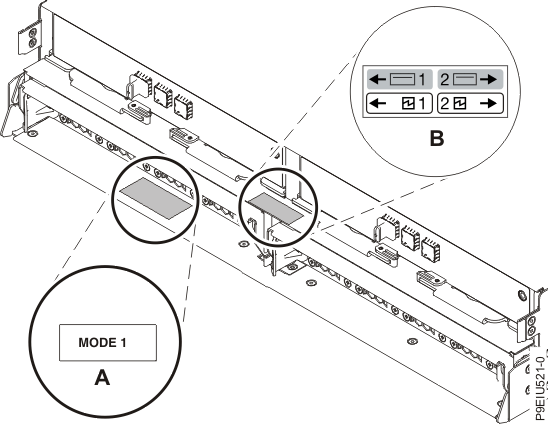
- Ensure that all adapters that you need to connect to the ESLL or ESLS storage enclosure are installed in the system or expansion unit. If the adapters are not installed, complete the adapter installation procedure for your system or expansion unit before you continue with this task. For instructions, see PCIe adapters.
-
If the system requires an internal cable to be installed to produce an external SAS port for
connection with the enclosure, confirm that the installation was completed.
Remember: When you install or confirm the use of an external SAS port, record the location of the external SAS port on the system. Later in this procedure, you are instructed to install the external SAS cable to this system connector location.
-
Determine the configuration that you use to cable the SAS adapter to the ESLL or ESLS storage enclosure. The following list shows some of the common
connections, but not all possible connection options. For more configuration options, see Planning for
serial-attached SCSI cables.
Notes:
- If you have a 9040-MR9 system and plan to install an FC EJ0K in PCIe slots C9 and C12, a connection of mode 1 for the ESLL or ESLS storage enclosure is not supported.
- If you use a YO12 cable to attach the ESLL or ESLS storage enclosure to the rear SAS ports of the 5105-22E, 9008-22L, 9009-22A, 9009-22G, 9223-22H, or 9223-22S, the SAS YO12 cable must not exceed the maximum supported length of 3 m (9.8 ft).
- A mode 1 connection of one ESLL or ESLS storage enclosure by using a YO12 cable to a single SAS adapter.
- A mode 1 connection of two ESLL or ESLS storage enclosures by using YO12 cables to a single SAS adapter.
- A mode 1 connection of one ESLL or ESLS storage enclosure by using YO12 cables to a SAS adapter pair.
- A mode 1 connection of two ESLL or ESLS storage enclosures by using YO12 cables to a SAS adapter pair.
- A mode 2 connection of one ESLL or ESLS storage enclosure by using YO12 cables to two independent SAS adapters.
- A mode 2 connection of one ESLL or ESLS storage enclosure by using
two YO12 cables to one FC EJ0K SAS adapter located in PCIe slot C12 in the 9040-MR9 system.Note: This option is only supported with the AIX® or Linux® operation system.
- A mode 2 connection of one ESLL or ESLS storage enclosure by using
two YO12 cables to two EJ0K SAS adapters located in PCIe slots C09 and C12 in the 9040-MR9 system.Note: This option is only supported with the AIX or Linux operation system.
- A mode 2 connection of two ESLL or ESLS storage enclosures by using four YO12 cables to two FC
EJ0K SAS adapters located in PCIe slots C09 and C12 in the 9040-MR9 system. Note: This option is only supported with the AIX or Linux operation system.
- A mode 2 connection of one ESLL or ESLS storage enclosure by using X12 cables to two SAS adapter pairs.
- A mode 4 connection of one ESLL or ESLS storage enclosure by using X12 cables to four independent SAS adapters.
-
Locate the connection for each adapter for which you are using an external SAS cable to connect
the enclosure. Adapter cables attach to ports at the rear of the systems in which the adapters are
installed.
To identify the SAS port location for the system in your configuration, see Connector locations and select the appropriate model.
-
Select from the following options:
- If the server or expansion unit that you are attaching your ESLL or ESLS storage enclosure to is powered off, continue with step 12.
- If the system is powered on, you must complete one of the following actions, depending on the
supported functions of your operating system:
- Unconfigure the adapters to which you are connecting the enclosure.
- Power off the adapters to which you are connecting the enclosure.
- Power off the logical partitions or systems that own the adapters to which you are connecting the enclosure.
To do one of these required actions, continue with step 8.
-
Do the following conditions apply to your situation?
- Your system model does not support slot power control.
- Your adapters are not in an I/O enclosure that supports slot power control.
- You are unable to tolerate a temporary loss of access to other disk
devices that might exist on the same adapters.
- Yes: Power off the system or the logical partitions that own the adapters. For instructions, see Stopping a system. Then, continue with step 12.
- No: Continue with step 9.
- Select from the following options:
-
To unconfigure the SAS adapters, complete these steps:
- Unconfigure the SAS adapters.
- Ensure that you have the electrostatic discharge (ESD) wrist strap attached. If not, attach it now.
- Connect the SAS cables from the enclosure to the SAS adapters.
- Reconfigure the SAS adapters.
- Continue with step 12.
-
To power off the SAS adapters, complete these steps:
- Power off the SAS adapters.
- Ensure that you have the electrostatic discharge (ESD) wrist strap on and that the ESD clip is plugged into a ground jack or connected to an unpainted metal surface. If not, do so now.
- Connect the SAS cables from the enclosure to the SAS adapters.
- Power on the SAS adapters.
- Configure the SAS adapters and devices.
- Continue with the next step.
-
Choose one of the following options to cable the SAS adapter:
Note: The configuration figures show the use of SAS adapters to represent the external server or expansion unit connections. The adapter can represent one of the following connection types:Note: Locate the connection for each adapter for which you are using an external SAS cable to connect the enclosure. Adapter cables attach to ports at the rear of the systems in which the adapters are installed. To identify the SAS port location for the system in your configuration, see Connector locations and select the appropriate model.
- To complete a mode 1 connection of one ESLL or ESLS storage enclosure by using a YO12 cable to a single FC EJ0J, FC EJ0K, or FC EJ0M SAS adapter, go to step 13.
- To complete a mode 1 connection of two ESLL or ESLS storage enclosures by using YO12 cables to a single FC EJ0L or FC EJ14 SAS adapter, go to step 14.
- To complete a mode 1 connection of one ESLL or ESLS storage enclosure by using YO12 cables to an EJ0L SAS adapter pair or an FC EJ14 SAS adapter pair, go to step 15.
- To complete a mode 1 connection of one enclosure by using two Y012 cables to an FC EJ14 SAS adapter pair located in PCIe slots C09 and C12 in the 9040-MR9 system with an adapter-to-adapter AA12 cable, go to step 17.
- To complete a mode 1 connection of two ESLL or ESLS storage enclosures by using YO12 cables to an EJ0L SAS adapter pair or an FC EJ14 SAS adapter pair, go to step 16.
- To complete a mode 2 connection of one ESLL or ESLS storage enclosure by using YO12 cables to two independent FC EJ0J, FC EJ0K, or FC EJ0M SAS adapters, go to step 18.
- To complete a mode 2 connection of one ESLL or ESLS storage enclosure by using two YO12 cables to one FC EJ0K SAS adapter located in slot C12 in the 9040-MR9 system, go to step 19.Note: This option is only supported with the AIX or Linux operation system.
- To complete a mode 2 connection of one ESLL or ESLS storage enclosure by using two YO12 cables to two FC EJ0K SAS adapters located in PCIe slots C09 and C12 in the 9040-MR9 system, go to step 20.Note: This option is only supported with the AIX or Linux operation system.
- To complete a mode 2 connection of two ESLL or
ESLS storage enclosures by using four YO12 cables to
two FC EJ0K SAS adapters located in slots C09 and C12 in the 9040-MR9 system, go to step 21.Note: This option is only supported with the AIX or Linux operation system.
- To complete a mode 2 connection of one ESLL or ESLS storage enclosure by using X12 cables to two FC EJ0L SAS adapter pairs or two FC EJ14 pairs, go to step 22.
- To complete a mode 4 connection of one ESLL or ESLS storage enclosure by using X12 cables to four independent FC EJ0J, FC EJ0K, or FC EJ0M SAS adapters, go to step 23.
If your SAS configuration requirements are not supported by any of these options, go to step 24.
-
Then, complete a mode 1 connection of one enclosure (A) by using a YO12
cable (B) to a single FC EJ0J, FC EJ0K, or FC EJ0M SAS adapter
(C), as shown in Figure 2 and then continue with Connecting cables, power cords, and installing covers.
Note: The single FC EJ0J, FC EJ0K, or FC EJ0M SAS adapter (C) has access to all 12 or 24 drive bays.
Figure 2. Mode 1 connection of one ESLL or ESLS storage enclosure by using a YO12 cable to a single FC EJ0J, FC EJ0K, or FC EJ0M SAS adapter 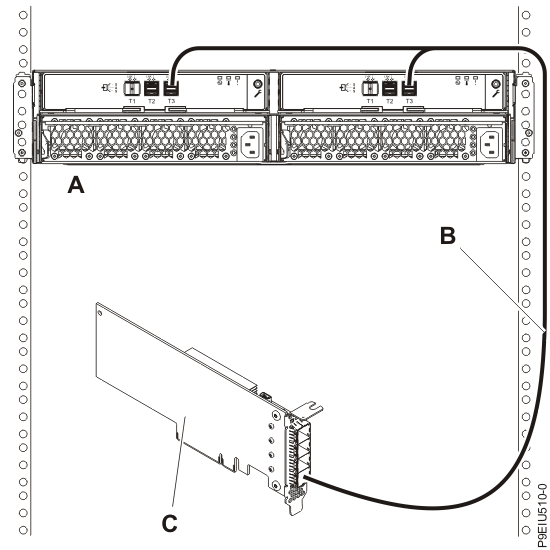
-
Then, complete a mode 1 connection of two enclosures (A and B) by using
YO12 cables (C and D) to a single FC EJ0J, FC EJ0K, or FC EJ0M SAS adapter
(E), as shown in Figure 3, and then continue with Connecting cables, power cords, and installing covers.
Note: The single SAS adapter (E) has access to all 24 or 48 drive bays.
Figure 3. Mode 1 connection of two ESLL or ESLS storage enclosures by using YO12 cables to a single FC EJ0J, FC EJ0K, or FC EJ0M SAS adapter 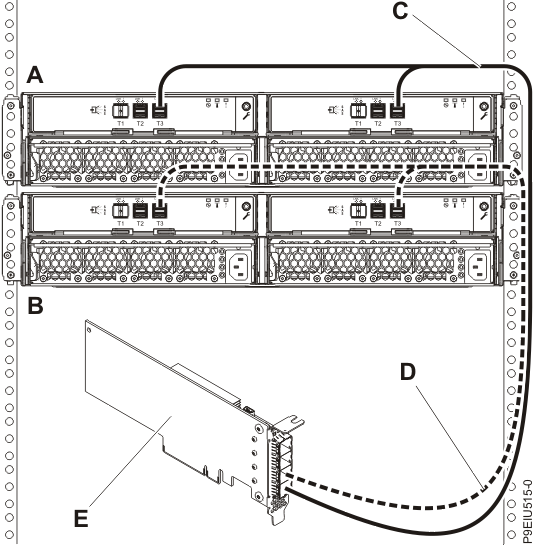
-
Then, complete a mode 1 connection of one enclosure
(A) by using YO12 cables (B) to an FC EJ0L SAS adapter
pair or an FC EJ14 SAS adapter pair (C) with adapter-to-adapter (AA) cables
(D), as shown in Figure 4, and then continue with Connecting cables, power cords, and installing covers.
Notes:
- Each adapter in the SAS adapter pair (C) has access to the other adapter and to all 12 or 24 drive bays.
- For SAS adapter pairs, you must attach the cables to the same port on both adapters.
- Both short legs of the cables must attach to the same side of the enclosure and both long legs of the cable must attach to the other side of the enclosure.
Figure 4. Mode 1 connection of one ESLL or ESLS storage enclosure by using YO12 cables to an FC EJ0L SAS adapter pair or an FC EJ14 SAS adapter pair with AA cables 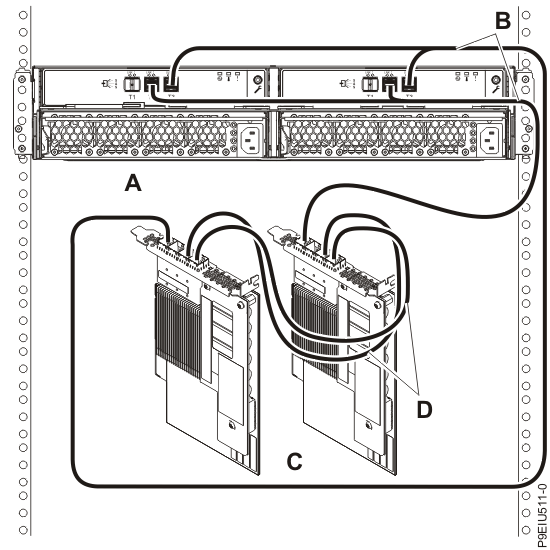
-
Then, complete a mode 1 connection of two enclosures (A and B) by using
YO12 cables (C and D) to an FC EJ0L SAS adapter pair or an FC EJ14 SAS
adapter pair (E) with AA cables (F), as shown in Figure 5 and then continue with Connecting cables, power cords, and installing covers.
Notes:
- Each adapter in the SAS adapter pair (E) has access to the other adapter and to all 24 or 48 drive bays.
- For SAS adapter pairs, you must attach the cables to the same port on both adapters.
- Both short legs of the cables must attach to the same side of the enclosure and both long legs of the cable must attach to the other side of the enclosure.
Figure 5. Mode 1 connection of two ESLL or ESLS storage enclosures by using YO12 cables to an FC EJ0L SAS adapter pair or an FC EJ14 SAS adapter pair with AA cables 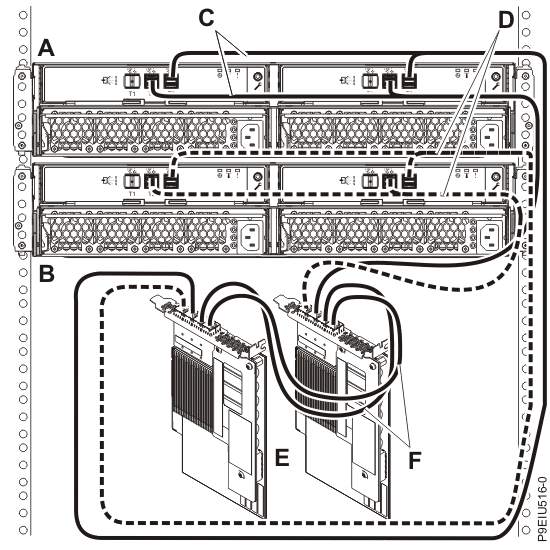
- Then, complete a mode 1 connection of one enclosure
(A) by using two Y012 cables (B) to an FC EJ14 SAS
adapter pair (C) located in PCIe slots C09 and C12 in the 9040-MR9 system
with adapter-to-adapter AA12 cable (D) as shown in Figure 6, and then continue with Connecting cables, power cords, and installing covers. Notes:
- Each adapter in the SAS adapter pair (C) has access to the other adapter and to all 12 or 24 drive bays.
- For SAS adapter pairs, you must attach the cables to the same port on both adapters.
- Both short legs of the cables must attach to the same side of the enclosure and both long legs of the cable must attach to the other side of the enclosure.
- The two bottom ports on the adapters (T0, T1) are dedicated to the cable connections for the internal drive bays.
- This option is only supported with the AIX or Linux operation system.
Figure 6. Mode 1 connection of one ESLL or ESLS storage enclosure by using YO12 cables to an FC EJ14 SAS adapter pair located in PCIe slots C09 and C12 in the 9040-MR9 system with an adapter-to-adapter AA12 cable 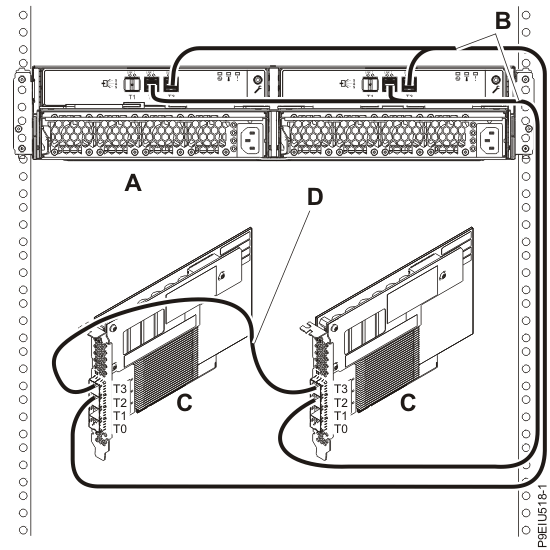
-
Complete a mode 2 connection of one enclosure (A) by using YO12 cables
(B) to two independent FC EJ0J, FC EJ0K, or FC EJ0M SAS adapters
(C and D), as shown in Figure 7. Then, continue with Connecting cables, power cords, and installing covers.
Notes:
- Independent SAS adapter 1 (C) does not have access to the other independent adapter and only has access to drive bays D1 - D12.
- Independent SAS adapter 2 (D) does not have access to the other independent adapter and only has access to drive bays D13 - D24.
Figure 7. Mode 2 connection of one ESLL or ESLS storage enclosure by using YO12 cables to two independent FC EJ0J, FC EJ0K, or FC EJ0M SAS adapters 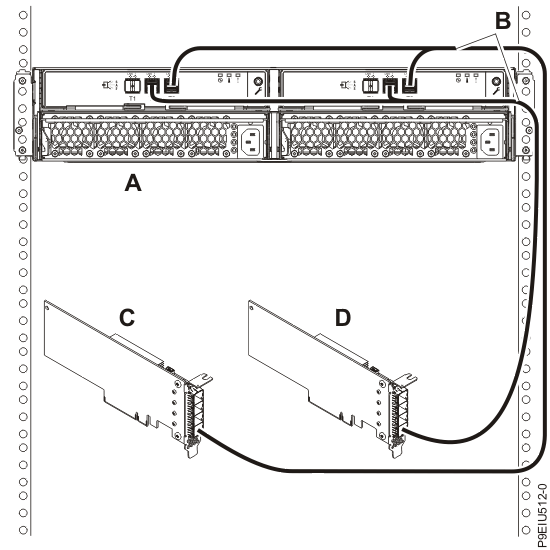
-
Complete a mode 2 connection of one enclosure (A) by using two YO12
cables (B) to an FC EJ0K adapter (C) located in PCIe
slot C12 in the 9040-MR9 system, as shown in Figure 8. Then, continue with Connecting cables, power cords, and installing covers.
Notes:
- The two bottom ports on the adapter (T0, T1) are dedicated to the cable connections for the internal drive bays.
- This option is only supported with the AIX or Linux operation system.
Figure 8. Mode 2 connection of one ESLL or ESLS storage enclosure by using two YO12 cables to an FC EJ0K SAS adapter located in PCIe slot C12 in the 9040-MR9 system 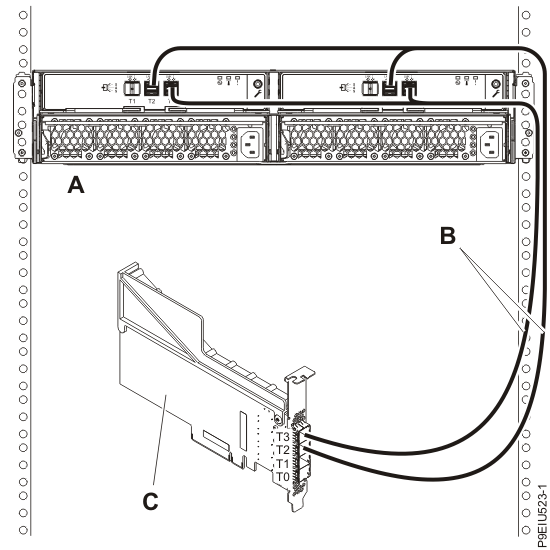
-
Complete a mode 2 connection of one enclosure (A) by using two Y012
cables (B) to two independent FC EJ0K adapters (C)
located in PCIe slots C09 and C12 in the 9040-MR9
system, as shown in Figure 9. Then,
continue with Connecting cables, power cords, and installing covers.
Notes:
- The two bottom ports on the adapter (T0, T1) are dedicated to the cable connections for the internal drive bays.
- This option is only supported with the AIX or Linux operation system.
Figure 9. Mode 2 connection of one ESLL or ESLS storage enclosure by using two YO12 cables to two FC EJ0K SAS adapters located in PCIe slots C09 and C12 in the 9040-MR9 system 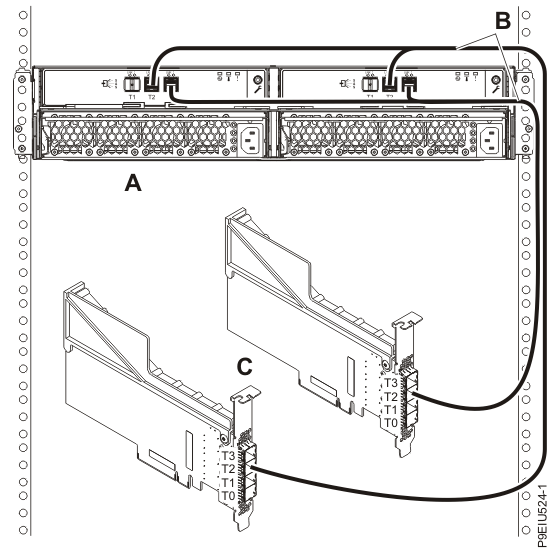
-
Complete a mode 2 connection of two enclosures (A) by using four YO12
cables (B) to two independent FC EJ0K adapters (C)
located in PCIe slots C09 and C12 in the 9040-MR9
system, as shown in Figure 10.
Then, continue with Connecting cables, power cords, and installing covers.
Notes:
- The two bottom ports on the adapter (T0, T1) are dedicated to the cable connections for the internal drive bays.
- This option is only supported with the AIX or Linux operation system.
Figure 10. Mode 2 connection of two ESLL or ESLS storage enclosures by using four YO12 cables to two FC EJ0K SAS adapters located in PCIe slots C09 and C12 in the 9040-MR9 system 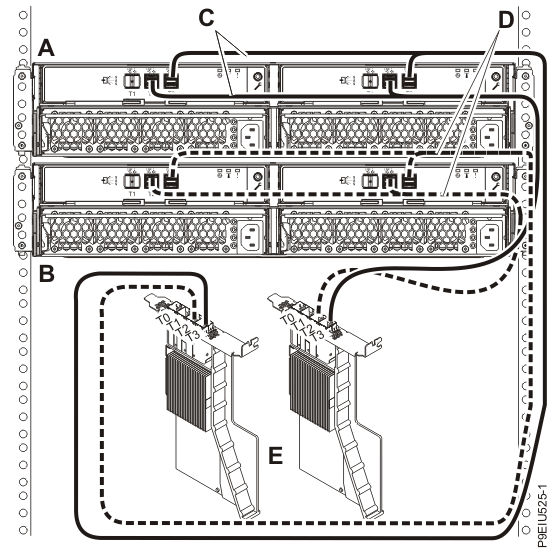
-
Complete a mode 2 connection of one enclosure (A) by using X12 cables
(B) to two FC EJ0L SAS adapter pairs or two FC EJ14 SAS adapter pairs
(C and D) with AA cables (E), as shown in Figure 11. Then, continue with Connecting cables, power cords, and installing covers.
Notes:
- Each adapter in the SAS adapter pair 1 (C) has access to the other adapter in pair 1 and to drive bays D1 - D12.
- Each adapter in the SAS adapter pair 2 (D) has access to the other adapter in pair 2 and to drive bays D13 - D24.
- For SAS adapter pairs, you must attach the cables to the same port on both adapters.
- Both short legs of the cables must attach to the same side of the enclosure and both long legs of the cable must attach to the other side of the enclosure.
Figure 11. Mode 2 connection of one ESLS by using X12 cables to two FC EJ0L SAS adapter pairs or two FC EJ14 SAS adapter pairs with AA cables 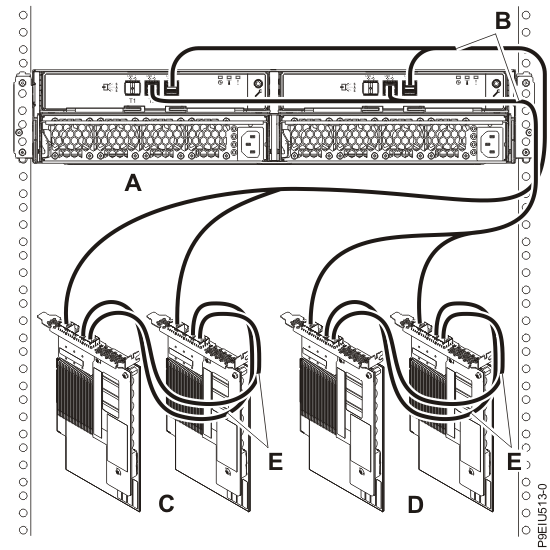
-
Complete a mode 4 connection of one enclosure (A) by using X12 cables
(B) to four independent FC EJ0J or FC EJ0M SAS adapters as shown in Figure 12. Then, continue with Connecting cables, power cords, and installing covers.
Note: Refer to Figure 13 for label examples of these cable identifiers.
- The cable that plugs into independent SAS adapter 1 (C) contains a label with the P1 identifier (G). This adapter does not have access to any other independent adapter and only has access to drive bays D1 - D6 (D1 - D3 for the ESLL).
- The cable that plugs into independent SAS adapter 2 (D) contains a label with the P2 identifier (G). This adapter does not have access to any other independent adapter and only has access to drive bays D7 - D12 (D4 - D6 for the ESLL).
- The cable that plugs into independent SAS adapter 3 (E) contains a label with the P1 identifier (G). This adapter does not have access to any other independent adapter and only has access to drive bays D13 - D18 (D7 - D9 for the ESLL).
- The cable that plugs into independent SAS adapter 4 (F) contains a label with the P2 identifier (G). This adapter does not have access to any other independent adapter and only has access to drive bays D19 - D24 (D10 - D12 for the ESLL).
Note: Partial mode 4 configurations are supported with less than 4 adapters leaving an adapter end of the X12 cable not connected.Figure 12. Mode 4 connection of one ESLL or ESLS storage enclosure by using X12 cables to four independent FC EJ0J or FC EJ0M SAS adapters 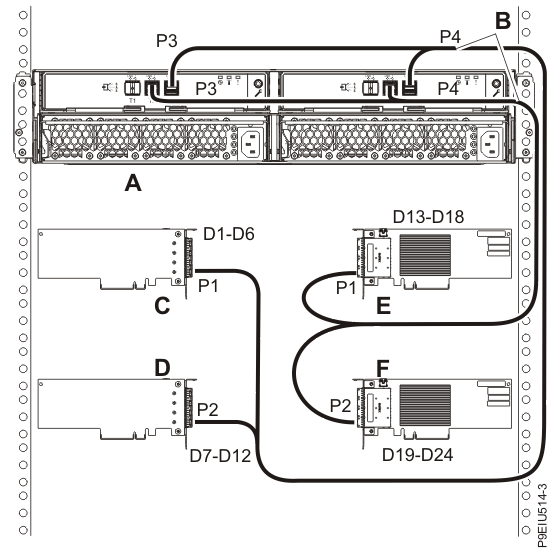
Figure 13. Labels for SAS adapter cables that show P1 and P2 identifiers 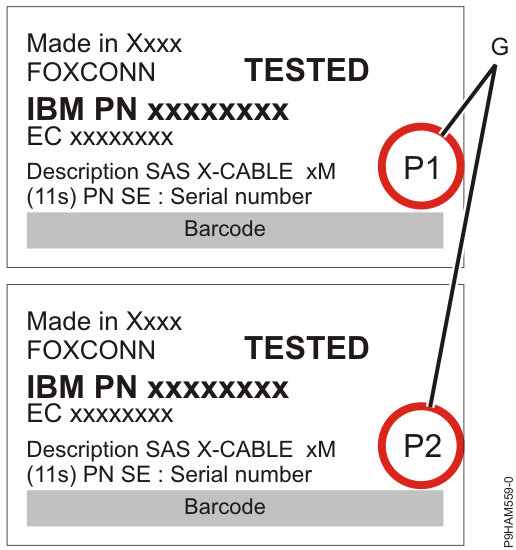
- For more information about SAS cabling and cabling configurations, see Cable management.